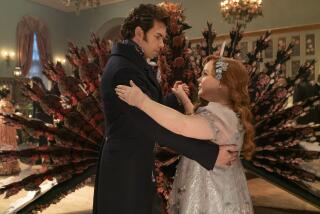DANCE REVIEW : BALLET WEST’S REVIVAL OF ‘ABDALLAH’
SALT LAKE CITY — From a newly revealed Sistine Chapel ceiling to a painstakingly restored version of the film musical “A Star Is Born,” cultural historians are reclaiming parts of our past that once seemed hopelessly lost.
So, too, in ballet, where Robert Joffrey is currently undertaking a reconstruction of Vaslav Nijinsky’s original version of “Le Sacre du Printemps”--and Ballet West here has staged what it calls the “20th-Century world premiere” of August Bournonville’s “Abdallah,” a three-act Arabian nights fantasy not danced since 1858.
Performed in the intimate, old-fashioned Capitol Theatre--itself a fine example of restoration--”Abdallah” emerged Wednesday as a triumph of loving scholarship and dedication to the highest standards of Bournonville style. It is also, not incidentally, enormous fun as a dance entertainment: a love story replete with danger, comedy, magic, pageantry and enough “new” Bournonville dances to reveal again the great Danish choreographer’s amazing range.
“Abdallah” has everything from a Middle-Eastern hornpipe for seven workmen--the kind of raucous, gritty folk romp that Eliot Feld recently mounted in “The Jig is Up”--to a grand scale harem divertissement that displays the women’s technique at its purest. In our time, only Ashton can move from character dance to classicism with equal brilliance.
“Abdallah” had its premiere in Copenhagen in 1855, a time when Bournonville had accepted a post in Vienna. Consequently, he made extensive notes in the musical score to help him restage the ballet in Austria.
These notes (now in the Royal Library, Copenhagen) served as the primary research tool for Toni Lander and Bruce Marks of Ballet West and Flemming Ryberg of the Royal Danish Ballet. All three had previously danced Bournonville in Copenhagen and had assimilated his style well enough to be able to intuit passages when the notes proved sketchy or impossible to decipher.
It also turned out that certain dances from “Abdallah” had been inserted into the last act of Bournonville’s classic “Napoli” early in the 20th Century--and these have now been put back where they belong.
Set in what is now Iraq, “Abdallah” follows the fortunes of a lovesick shoemaker who is given a magic five-branched candelabrum.
“You can light up to four candles,” he is told (in pantomime). “But not the fifth.” Candle one gives him new clothes; two, a palace; three, a harem; four, peace from a nagging mother-in-law-elect. Will he have the strength of character to remain uncorrupted by his new wealth--and leave the last candle unlit? Of course not. Will he be reunited with his dainty sweetheart (known as “the Gazelle of Basra”)? Of course. There would be no pas de deux in “Abdallah” otherwise. And what is a Bournonville ballet without a lacey, effervescent duet in which ballerina and danseur bound alongside each other as happy as Basran gazelles?
Ballet West has produced “Abdallah” with enormous taste and considerable splendor. Holger Simon Paulli’s charming score has been entrusted to the Utah Symphony under Varujan Kojian. Designer Jens-Jacob Worsaae has given the exotic vistas the luminous delicacy of watercolors and his costumes combine tutus and harem pants with sly Danish wit.
It would be extravagant to claim that Ballet West dances “Abdallah” with the peerless suavity and sparkle of the Royal Danish Ballet. However, this has always been one of the best regional companies in America and the dancers seem far more comfortable than other non-Danes with the special demands of Bournonville technique: the intricate legwork and nonstop fluidity of the combinations, the distinctive port de bras in jumps, the emphasis on mime. Best of all, they dance Bournonville like play rather than like some kind of test, and their enjoyment is contagious.
With Marks himself authoritatively impersonating a warrior-sheik, the cast is headed by the capable, personable Miguel Garcia as the shoemaker, the winsome but not always ideally secure Lee Provancha Day as his Gazelle and the colorless but competent Odette Millner as the principal harem distraction.
As in any properly produced Bournonville ballet, a large complement of older mime-actors and young children supply additional variety, energy, warmth--plus the sense of a unified society deeply engrained in all of Bournonville’s surviving full-length works.
More to Read
The biggest entertainment stories
Get our big stories about Hollywood, film, television, music, arts, culture and more right in your inbox as soon as they publish.
You may occasionally receive promotional content from the Los Angeles Times.










